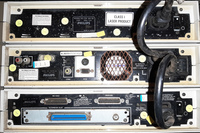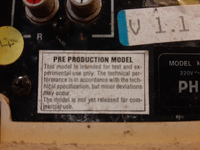Philips CD-i Pre Production 180/181/182/ Professional Multimedia Console
| Home > Browse Our Collection > Games Consoles > Philips > Philips CD-i Pre Prod ... al Multimedia Console |
|
This is a pre production model of the Philips 180/20 machine, which was a professional version of the CDi family aimed at the education market.
Jointly developed by Philips and Kyocera, the machine has 3 units, the top one is the CDi 180.
The middle unit is the MMC 181, or Multi Media Controller, this was for video output, and also houses the input ports and volume control, it also has an IC slot for 8K cards, replaced in later machines by a time keeper chip.
The bottom unit is the 182 expansion rack, which was used for authoring purposes, with two 3.5 floppy drives, SCSI, printer and parallel ports. Only the top two units are needed for operation.
The Philips CD-i (Compact Disc Interactive) is an interactive multimedia CD player developed and marketed by Royal Philips Electronics N.V. This category of device was created to provide more functionality than an audio CD player or game console, but at a lower price than a personal computer with a CD-ROM drive at the time.
The cost savings were due to the lack of a hard drive, floppy drive, keyboard, mouse, monitor (a standard television was used), and less operating system software.
CD-i also refers to the multimedia Compact Disc standard used by the CD-i console, also known as Green Book, which was developed by Philips and Sony (not to be confused with MMCD, the pre-DVD format also co-developed by Philips and Sony). Work on the CD-i began in 1984 and it was first publicly announced in 1986.
The first Philips CD-i player, released in 1991 and initially priced around USD $700, is capable of playing interactive CD-i discs, Audio CDs, CD+G (CD+Graphics), Karaoke CDs, and Video CDs (VCDs), though the last requires an optional "Digital Video Card" (DVG) to provide MPEG-1 decoding, as do some of the machine’s better games.
This additional cost made the machine prohibitively expensive compared to rival systems, such as the SNES and Mega Drive, this version of the CDi could not be extended with the DVC.
The CD-i proved to be a commercial failure in that market segment, Philips ceased publishing video games for the platform in 1998.
Among the system’s weaknesses are just having 2 channels for sound, meaning that music for games must be in one, and sound effects in the other, or momentarily stop the machine from playing music.
The console is probably best known for being home to some Nintendo licensed games. Products of a deal struck between the two companies when Nintendo cancelled a proposed CD drive for the SNES. Three Zelda games and one featuring Mario were well received at the time, but thanks to internet folklore, they are often met with derision.
The Pre Production label on the rear reads:
'Pre Production Model This model is for test and experimental use only. The technical performance is in accordance with the technical specifications, but minor deviations may occur. The model is not yet released for commercial use.'
16-bit 68070 CISC Chip Manufacturer: Philips Other Systems Related To Philips CD-i Pre Production 180/181/182/ Professional Multimedia Console:
This exhibit has a reference ID of CH53105. Please quote this reference ID in any communication with the Centre for Computing History. |
Click on the Image(s) For Detail
|













